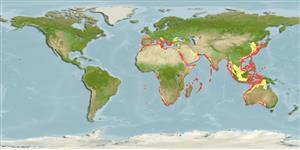Common names from other countries
Environment: milieu / climate zone / depth range / distribution range
Ecologia
; intervalo de profundidade 3 - 600 m (Ref. 804), usually 300 - 400 m (Ref. 804). Subtropical; 48°N - 37°S, 13°W - 139°E
Indo-West Pacific, Eastern Atlantic and the Mediterranean: eastern Atlantic from Gulf of Biscay to Congo and around the Mediterranean, and it is widely distributed throughout the coasts of Morocco.
Length at first maturity / Tamanho / Peso / Idade
Maturity: Lm ? range ? - ? cm Max length : 7.8 cm TL macho/indeterminado; (Ref. 804)
Minimum depth from Ref. 881. Nektobenthic (demersal) or epibenthic at depths between 75 to 600 m. Infaunal feeder (Ref. 106512). Feeds on euphausiids and mollusks (Ref. 52384).
Life cycle and mating behavior
Maturidade | Reprodução | Desova | Ovos | Fecundidade | Larvas
Members of the order Decapoda are mostly gonochoric. Mating behavior: Precopulatory courtship ritual is common (through olfactory and tactile cues); usually indirect sperm transfer.
Bianchi, G., K.E. Carpenter, J.-P. Roux, F.J. Molloy, D. Boyer and H.J. Boyer. 1999. (Ref. 804)
Categoria na Lista Vermelha da IUCN (Ref. 130435)
Categoria CITES (Ref. 108899)
Not Evaluated
Not Evaluated
Utilização humana
| FishSource |
Ferramentas
Fontes da internet
Estimates based on models
Preferred temperature
(Ref.
115969): 8.6 - 15.9, mean 11.6 (based on 245 cells).
Resiliência
Elevada, tempo mínimo de duplicação da população menor que 15 meses (K=0.4-0.48).
Vulnerabilidade
Low vulnerability (10 of 100).
